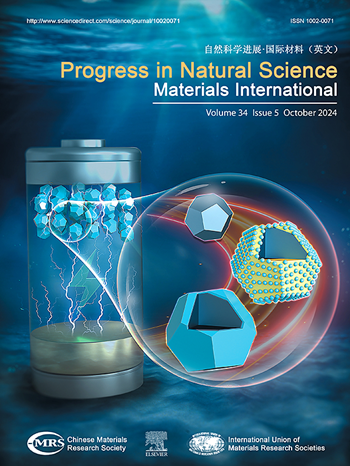Ethylbenzene adsorption on pristine, doped and vacancy-defective Ti2C nanosheets: A DFT study
IF 7.1
2区 材料科学
Q2 MATERIALS SCIENCE, MULTIDISCIPLINARY
Progress in Natural Science: Materials International
Pub Date : 2025-04-01
DOI:10.1016/j.pnsc.2025.02.002
引用次数: 0
Abstract
The optimized atomic structures, energetics and electronic structures of ethylbenzene adsorption systems on pristine, doped and vacancy-defective Ti2C nanosheets respectively have been investigated using first-principles method based on density functional theory to explore their potential ethylbenzene adsorption and detection capabilities. It is found that various vacancy defects improve the ethylbenzene adsorption energies of Ti2C nanosheet. While, the adsorption behavior of ethylbenzene molecule on doped Ti2C nanosheet varies with the difference of doping atoms. Among them, the Si-doped and Mn-doped Ti2C respectively show good adsorption potential. Charge transfer mechanisms between ethylbenzene and various Ti2C nanosheets have been studied through the Bader charge and differential charge density analysis to explore the deep origin of the underlying electronic structure changes. This theoretical work is proposed to predict the adsorption and sensing potential of various Ti2C nanosheets towards ethylbenzene (a kind of gas marker for lung cancer) and would help to guide experimentalists to develop better Ti2C-based 2-D materials for gas detection applications in the future.
原始、掺杂和空位缺陷Ti2C纳米片对乙苯的吸附:DFT研究
采用基于密度泛函理论的第一性原理方法,分别研究了原始、掺杂和空缺缺陷Ti2C纳米片上乙苯吸附体系的优化原子结构、能量学和电子结构,探讨了它们对乙苯的潜在吸附和检测能力。发现各种空位缺陷提高了Ti2C纳米片对乙苯的吸附能。而乙苯分子在掺杂Ti2C纳米片上的吸附行为随掺杂原子的不同而不同。其中,si掺杂和mn掺杂的Ti2C分别表现出良好的吸附势。通过Bader电荷和差分电荷密度分析,研究了乙苯与各种Ti2C纳米片之间的电荷转移机制,探讨了潜在电子结构变化的深层原因。这项理论工作旨在预测各种Ti2C纳米片对乙苯(一种肺癌气体标志物)的吸附和传感潜力,并有助于指导实验人员在未来开发更好的Ti2C基二维气体检测材料。
本文章由计算机程序翻译,如有差异,请以英文原文为准。
求助全文
约1分钟内获得全文
求助全文
来源期刊
CiteScore
8.60
自引率
2.10%
发文量
2812
审稿时长
49 days
期刊介绍:
Progress in Natural Science: Materials International provides scientists and engineers throughout the world with a central vehicle for the exchange and dissemination of basic theoretical studies and applied research of advanced materials. The emphasis is placed on original research, both analytical and experimental, which is of permanent interest to engineers and scientists, covering all aspects of new materials and technologies, such as, energy and environmental materials; advanced structural materials; advanced transportation materials, functional and electronic materials; nano-scale and amorphous materials; health and biological materials; materials modeling and simulation; materials characterization; and so on. The latest research achievements and innovative papers in basic theoretical studies and applied research of material science will be carefully selected and promptly reported. Thus, the aim of this Journal is to serve the global materials science and technology community with the latest research findings.
As a service to readers, an international bibliography of recent publications in advanced materials is published bimonthly.

 求助内容:
求助内容: 应助结果提醒方式:
应助结果提醒方式:


